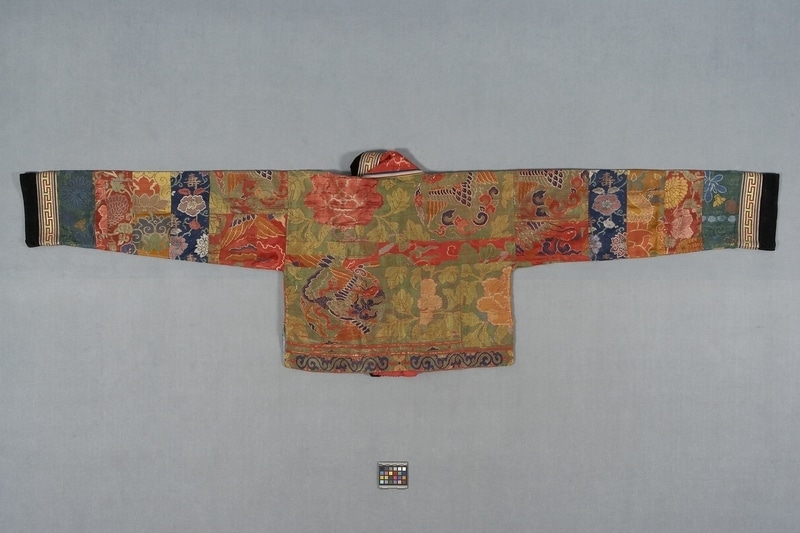Jacket Item Number: 2508/4 from the MOA: University of British Columbia


Description
Man’s short multicoloured ceremonial jacket constructed from a patchwork of colourful brocade textiles and trimmed at collar and cuffs with velvet. The jacket is voluminous, with very long sleeves; a T-shaped garment with centre front opening, without closures or fasteners. The front opening is finished with a very wide border (approximately 23.5 cm), which extends to the back of the jacket to form a high collar at centre back. This border consists of four different bands: a 2.7 cm wide band of striped, multicoloured embroidery; a 10 cm wide band of red silk brocade embellished with gold metallic figures of cranes and Chinese(?) characters; a 5.6 cm wide band of finely embroidered blue, green, red, pink and white stitchery in a T-shaped repeated motif; and a 5.1 cm wide band of black cotton velvet textile. The same multicoloured embroidery and black velvet is used to finish the cuffs. The jacket is lined with blue and red light weight silk brocade.
History Of Use
Short jacket called a gyalu-cheng phodthu, possibly of 19th century fabrics. Worn by a government official, a minister, only on the first day of the New Year. It was worn over a long robe, and a special ‘rainbow’ shawl would be worn over his shoulders. Passed through the family from father to son.
Narrative
Yapshi-Yuthok Kalon Tashi Dhondup Collection: The title Yapshi is given to all families that have a Dalai Lama born into the family, and Shape and Kalon are titles that the four lay Cabinet Ministers hold. The Yuthok family is descended from the 10th Dalai Lama, Tsultrim Gyatso. Being a Minister in the Traditional Tibetan Government, Yapshi-Yuthok Tashi Dhondup was also known as Shape or Kalon Yuthok. There is one item belonging to Kalon Yuthok that is in the collection of the Metropolitan Museum: a Tibetan saddle, which he used on special occasions and during the Tibetan New Year when he would go to the Potala Palace. It was the wish of the late Mrs. Tsering Dolkar Yapshi-Yuthok that the museum display the family's heirloom textiles so that visitors could learn about Tibet's rich history and culture.
Item History
- Made in Tibet during 1800
- Owned by Yuthok Family before July 27, 2000
- Received from Fyfe-Smith Memorial Oriental Collection Fund (Funding source) and Yuthok Family (Seller) on July 27, 2000
What
- Name
- Jacket
- Identification Number
- 2508/4
- Type of Item
- jacket
- Material
- gold metal, cotton fibre ?, silk fibre and dye
- Overall
- height 63.0 cm, width 215.0 cm, depth 18.6 cm
Who
- Culture
- Tibetan
- Previous Owner
- Yuthok Family
- Received from
- Fyfe-Smith Memorial Oriental Collection Fund (Funding source) and Yuthok Family (Seller)
Where
- Holding Institution
- MOA: University of British Columbia
- Made in
- Tibet
When
- Creation Date
- during 1800
- Ownership Date
- before July 27, 2000
- Acquisition Date
- on July 27, 2000
Other
- Item Classes
- textiles
- Condition
- fair
- Accession Number
- 2508/0004